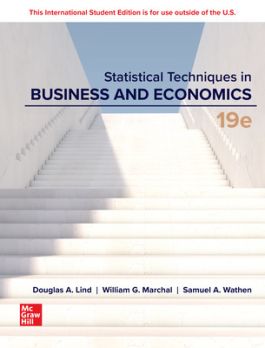Statistical Techniques in Business and Economics ISE
1 What Is Statistics?
2 Describing Data: Frequency Tables, Frequency Distributions, and Graphic Presentation
3 Describing Data: Numerical Measures
4 Describing Data: Displaying and Exploring Data
5 A Survey of Probability Concepts
6 Discrete Probability Distributions
7 Continuous Probability Distributions
8 Sampling, Sampling Methods, and the Central Limit Theorem
9 Estimation and Confidence Intervals
10 One-Sample Tests of Hypothesis
11 Two-Sample Tests of Hypothesis
12 Analysis of Variance
13 Correlation and Linear Regression
14 Multiple Regression Analysis
15 Nonparametric Methods Nominal Level Hypothesis Tests
16 Nonparametric Methods: Analysis of Ordinal Data
17 Index Numbers
18 Forecasting with Time Series Analysis
19 Statistical Process Control and Quality Management
20 An Introduction to Decision Theory (Online Only)
Appendixes
Appendixes, Data Sets, Tables, Software Commands, Answers
From its origins in 1976, Statistical Techniques in Business and Economics has become a best seller, providing students across the business specialisms with an introductory survey of descriptive and inferential statistics. With a step-by-step approach and clear writing style, any student can learn and succeed in Business Statistics.
The new edition includes a focus on the development of basic data analytical skills. Microsoft Excel, Minitab, and MegaStat are used throughout the text to illustrate statistical software analyses, and screen captures are used within the chapters, so the student becomes familiar with the nature of the software output. Additional resources are available online through Connect, with references or links in the text to Excel tutorials that provide users with clear demonstrations using statistical software to create graphical and descriptive statistics and analyses to test hypotheses.
What's changed:
The Nineteenth Edition made several changes to the flow and organization of the text by adding the sampling distribution of the proportion to Chapter 8, moving the one- and two-sample tests of hypothesis for proportions to Chapters 10, preceding the two-sample tests of hypothesis in Chapter 11 with the F-distribution, and the revision of several Chapter introductions.
Many of the calculation examples have been replaced with interpretative ones to help students understand and interpret the statistical results with more emphasis on the conceptual nature of the topics.
This edition also brings a renewed recognition of diversity, equity, and inclusion to the text, exercises, and examples through an increased diversity of persons and businesses from varied geographic, ethnic, and cultural groups.
McGraw Hill Connect is an award-winning digital teaching and learning solution that empowers students to achieve better outcomes and enables instructors to improve course management efficiency.
High-Quality Course Material
Our trusted solutions are designed to help students actively engage in course content and develop critical higher-level thinking skills while offering you the flexibility to tailor your course to the ways you teach and the ways your students learn.
Assignments & Automatic Grading
Connect features a question bank that you can select from to create homework, practice tests and quizzes. Dramatically reduce the amount of time you spend reviewing homework and grading quizzes, freeing up your valuable time to spend on teaching.
Analytics & Reporting
Monitor progress and improve focus with Connect’s visual and actionable dashboards. Reports are available to empower both instructors and students with real-time performance analytics.
Seamless Integration
Link your Learning Management with Connect for single sign-on and gradebook synchronization, with all-in-one ease for you and your students.


